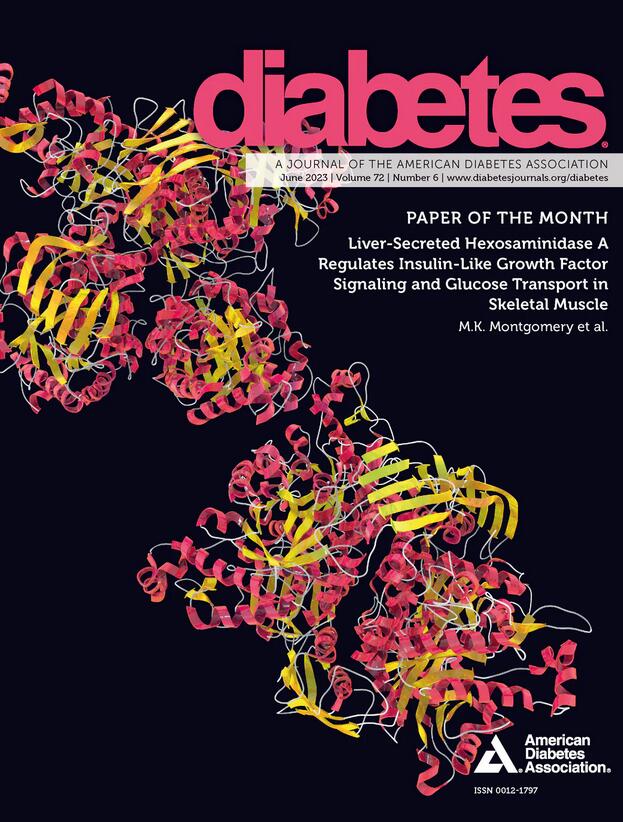197-OR: Algorithmic Identification May Improve Racial and Ethnic Diversity of Clinical Study Recruitment
IF 6.2
1区 医学
Q1 ENDOCRINOLOGY & METABOLISM
引用次数: 0
Abstract
Introduction: Early analyses of Rare and Atypical Diabetes Network (RADIANT) study recruitment suggested that goals to recruit underrepresented groups were not being met. We tested whether a validated electronic health record (EHR) algorithm to identify people with an atypical form of diabetes improved identification of racially and ethnically minoritized individuals who may be candidates for the RADIANT study. Methods: Individuals identified by the algorithm were reviewed by research assistants, then classified by endocrinologists as atypical diabetes, a known type of diabetes, or unable to classify (more information needed). Chi-squared tests were used to compare the proportion of self-reported non-Hispanic Black (NHB) and Hispanic or Spanish-speaking (H/SS) participants enrolled through the Mass General site prior to use of the algorithm (mainly through referral by expert clinicians) and proportion of potential individuals identified by the algorithm. Results: Prior to beginning recruitment through the EHR algorithm, 53% of participants enrolled in RADIANT from the Mass General Brigham site identified as NHW, 5% as NHB, 5% as H/SS, 20% as non-Hispanic Asian (NHA). The algorithm initially identified 539 individuals with potentially atypical forms of diabetes. Of these, 452 under the age of 85 were reviewed, and 93 (20.6%) were classified as atypical and possible RADIANT candidates (v. 65.7% with a known type of diabetes and 13.7% unable to be classified). Of those with likely atypical diabetes, 39.8% identified as NHW, 22.6% as NHB, 11.8% as H/SS, and 20.4% as NHA. The algorithm identified a higher percentage of NHB individuals (p<0.001) and H/SS individuals (p<0.001) when compared to previous recruitment methods. Conclusion: Use of a validated algorithm to identify individuals with atypical diabetes in the EHR led to improved identification of candidates for the RADIANT study who are historically underrepresented in clinical and genetic research studies. Disclosure S. Cromer: Other Relationship; Johnson & Johnson Medical Devices Companies. Advisory Panel; Alexion Pharmaceuticals, Inc. Other Relationship; Wolters Kluwer Health. V. Chen: None. M. Koss: None. M.M. Fan: None. C.I. Fernández Hernández: None. W.G. Marshall: Employee; Abbott. E. Greaux: None. M. Udler: Other Relationship; Up-To-Date. Funding American Diabetes Association (7-21-JDFM-005); NIDDK (1U54DK118612)197-OR: 算法识别可改善临床研究招募的种族和民族多样性
简介:对罕见和非典型糖尿病网络(RADIANT)研究招募的早期分析表明,招募代表性不足群体的目标并未实现。我们测试了一种用于识别非典型糖尿病患者的有效电子健康记录(EHR)算法是否能更好地识别可能成为 RADIANT 研究候选者的少数种族和民族群体。方法:由研究助理对算法识别出的个体进行审查,然后由内分泌专家将其分为非典型糖尿病、已知糖尿病类型或无法分类(需要更多信息)。使用卡方检验比较了在使用该算法之前通过麻省总医院网站注册的非西班牙裔黑人(NHB)和西班牙裔或讲西班牙语的参与者(H/SS)的比例(主要通过专家临床医生的转诊)和该算法识别的潜在个体的比例。结果:在通过电子病历算法开始招募之前,从马萨诸塞州综合医院布里格姆分院招募的 RADIANT 参与者中,53% 的人被认定为非华裔,5% 的人被认定为非华裔,5% 的人被认定为华裔,20% 的人被认定为非西班牙裔亚裔。该算法最初确定了 539 名可能患有非典型糖尿病的患者。其中,452 名 85 岁以下的患者接受了复查,93 人(20.6%)被归类为非典型糖尿病患者,可能是 RADIANT 的候选者(与已知糖尿病类型的 65.7% 和无法归类的 13.7% 相比)。在可能患有非典型糖尿病的患者中,39.8% 被确定为 NHW,22.6% 被确定为 NHB,11.8% 被确定为 H/SS,20.4% 被确定为 NHA。与之前的招募方法相比,该算法识别出的 NHB 人群(p<0.001)和 H/SS 人群(p<0.001)比例更高。结论:使用经过验证的算法识别电子病历中的非典型糖尿病患者,有助于更好地识别 RADIANT 研究的候选者,而这些候选者在临床和基因研究中的代表性历来不足。披露 S. Cromer:其他关系;强生医疗器械公司。顾问团;Alexion Pharmaceuticals, Inc.其他关系;Wolters Kluwer Health。V. Chen:无。M. Koss:无:无。M.M. Fan:无。C.I. Fernández Hernández: None.W.G. Marshall:雇员;Abbott.E. Greaux: None.M. Udler:其他关系;最新。资助机构 美国糖尿病协会 (7-21-JDFM-005);NIDDK (1U54DK118612)
本文章由计算机程序翻译,如有差异,请以英文原文为准。
求助全文
约1分钟内获得全文
求助全文
来源期刊

Diabetes
医学-内分泌学与代谢
CiteScore
12.50
自引率
2.60%
发文量
1968
审稿时长
1 months
期刊介绍:
Diabetes is a scientific journal that publishes original research exploring the physiological and pathophysiological aspects of diabetes mellitus. We encourage submissions of manuscripts pertaining to laboratory, animal, or human research, covering a wide range of topics. Our primary focus is on investigative reports investigating various aspects such as the development and progression of diabetes, along with its associated complications. We also welcome studies delving into normal and pathological pancreatic islet function and intermediary metabolism, as well as exploring the mechanisms of drug and hormone action from a pharmacological perspective. Additionally, we encourage submissions that delve into the biochemical and molecular aspects of both normal and abnormal biological processes.
However, it is important to note that we do not publish studies relating to diabetes education or the application of accepted therapeutic and diagnostic approaches to patients with diabetes mellitus. Our aim is to provide a platform for research that contributes to advancing our understanding of the underlying mechanisms and processes of diabetes.
 求助内容:
求助内容: 应助结果提醒方式:
应助结果提醒方式:


